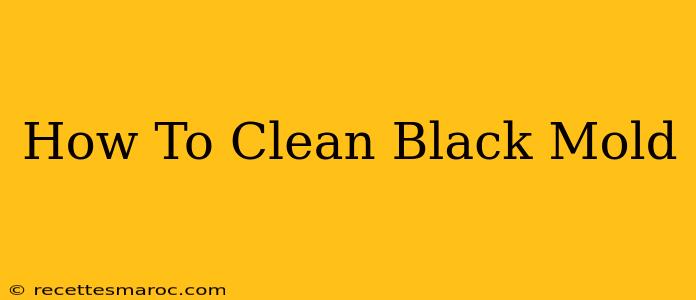Black mold, officially known as Stachybotrys chartarum, is a type of fungus that thrives in damp, humid environments. It's notorious for its dark, black or greenish-black coloring and musty odor, and more importantly, its potential health hazards. Cleaning black mold is not a task to take lightly. Exposure can trigger allergic reactions, respiratory problems, and other health issues, especially in vulnerable populations like children and the elderly. This guide will outline safe and effective methods for cleaning black mold, emphasizing when professional help is absolutely necessary.
Identifying Black Mold
Before you start cleaning, it's crucial to positively identify the presence of black mold. While many dark spots might appear moldy, not all are. Some could be mildew, dirt, or even just discoloration. If you're unsure, consider these factors:
- Appearance: Black mold is typically dark green, black, or grayish-black. It often appears slimy or fuzzy in texture.
- Location: It often grows in areas with high moisture, such as bathrooms, basements, or areas with water leaks.
- Odor: Black mold often has a musty, earthy, or even slightly sweet smell.
If you suspect black mold, it's best to err on the side of caution.
When to Call a Professional Mold Remediation Specialist
This is the most important section. Attempting to clean extensive black mold infestations yourself can be dangerous and ineffective. You should always consult a professional for:
- Large infestations: If the mold covers a significant area (more than 10 square feet), professional remediation is recommended.
- Hidden mold: Mold hidden within walls or ceilings requires specialized equipment and techniques for removal.
- Health concerns: If you or anyone in your household has respiratory issues or allergies, professional help is crucial to minimize exposure.
- Uncertainty: If you're unsure whether you're dealing with black mold or if you're uncomfortable tackling the situation, professional mold remediation is the safest option.
Cleaning Small Black Mold Patches (ONLY if you are absolutely sure it's a small patch and you're comfortable taking this on)
Safety First:
- Wear protective gear: This includes gloves, a respirator mask (N95 or better), eye protection, and long sleeves and pants to cover your skin.
- Ventilation: Open windows and doors to ensure good ventilation. Use fans to help circulate air and remove spores.
Cleaning Process (For very small areas ONLY):
- Prepare the area: Remove any loose debris or furniture from the area to be cleaned.
- Mix cleaning solution: Combine one cup of bleach with one gallon of water. Never mix bleach with ammonia or other cleaning agents.
- Apply solution: Carefully apply the solution to the moldy area using a spray bottle or sponge.
- Scrub gently: Use a scrub brush or stiff sponge to gently scrub the affected area. Avoid spreading the mold to other areas.
- Rinse thoroughly: Rinse the area thoroughly with clean water to remove all traces of the bleach solution.
- Dry completely: Allow the area to dry completely. Use fans to expedite the drying process. Moisture is crucial for mold growth.
Preventing Black Mold Growth
The best way to deal with black mold is to prevent it from growing in the first place. Here's how:
- Fix leaks promptly: Repair any leaks or water damage immediately.
- Improve ventilation: Ensure adequate ventilation in bathrooms and other moisture-prone areas. Use exhaust fans.
- Reduce humidity: Use a dehumidifier to lower humidity levels, especially in basements and crawl spaces.
- Clean regularly: Regularly clean and disinfect surfaces to prevent mold growth.
- Address moisture immediately: Wipe up spills and leaks instantly.
Conclusion
Black mold can pose serious health risks, and its removal should be handled with caution. While this guide outlines steps for cleaning small patches, remember that professional remediation is often the safest and most effective approach. Don't hesitate to contact a qualified mold remediation specialist if you have any concerns or if the infestation is more than a small, isolated patch. Your health is paramount.

